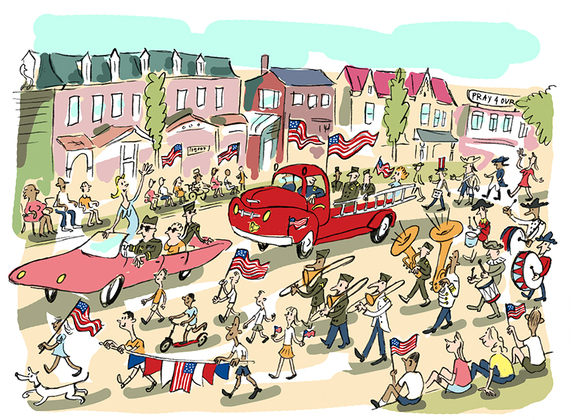The official kickoff for the American summer was Memorial Day. Steaks are slapped on the barbecue, swimming pools are opened. The grass, which a couple of weeks ago was still hidden under a blanket of snow, has reasserted itself. America remembers its soldiers killed in action, preferably with a parade, which, surprisingly enough, is a festive event. And my new home town of Princeton, NJ, where I moved two years ago from Holland, is no exception. I take my place on Nassau Street, next to a couple of children. They're carrying little flags that are being handed out for free a short distance away. The man on the sidewalk across from me is carrying a piece of cardboard with "Vietnam veteran" scratched onto it in pencil. He looks pretty seedy with his long, stringy hair and dirty clothes.
The procession begins with a few World War II veterans, decked out in war medals and waving cheerfully at the children from their wheelchairs. Then comes a mishmash of banner-waving girls, boy scouts in neatly ironed uniforms, chanting cadets and marching military bands.
I walk behind them under a watery sun to the monument commemorating the Battle of Princeton. It's an enormous stone relief on which General Washington, seated high on his horse, triumphs over the British.
This turning point in the Revolutionary War, on January 3, 1777, took place in our backyard. The bullet holes are still in the walls of our house.
The modest ceremony begins with the national anthem sung by a girls' choir. Then a boy scout in shorts rings a bronze bell. This isn't any old bell, by the way. It comes from the first USS Princeton, a warship built in 1842 and named after the famous battle that took place here. Two years later, during a demonstration for high-ranking dignitaries in Washington, the ship exploded as a result of a blunder committed by the captain. A number of the cabinet members were killed, among them the Secretary of State and the Secretary of the Navy. The president, John Tyler, survived because he happened to be below decks. But his personal servant, the slave Armistead, was lost.
Later that afternoon I walk into the neo-gothic university chapel in the heart of the campus. Preserved here is the flag from the fourth naval ship to bear the name Princeton. During World War II this aircraft carrier fought in many important battles in the Pacific. Finally she sank after a devastating air attack by Japanese dive bombers, taking more than a hundred men with her to the bottom of the sea. The flag was saved. I found it at the back of the empty chapel, hanging in a wooden frame. The stars are still shining but the stripes are badly frayed at the ends.
USS Princeton number five fought in Korea and Japan. Now we're up to the sixth, which at the moment is part of the Pacific fleet. This cruiser saw fighting at close quarters in both Iraq and Afghanistan and was badly hit during Operation Desert Storm.
This country has been almost constantly at war. The last hundred years have seen both world wars, Korea, Vietnam and the Gulf up to and including Iraq and Afghanistan. All that fighting has left its mark. At the present moment there are more than 21 million veterans in America. 7.4 million of them alone served in Vietnam. About 3.5 million ex-servicemen sustained injuries that left them partially or completely disabled. That's one American in a hundred.
On the way back home I pass the Vietnam veteran. He's still sitting in the same place, his piece of cardboard lying like pulp in the drizzling rain.
